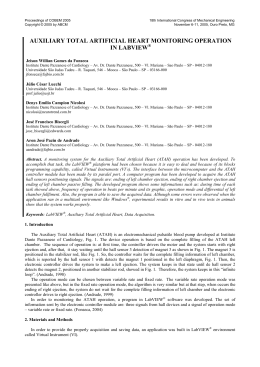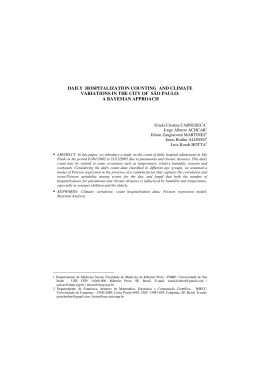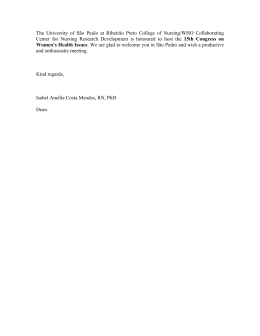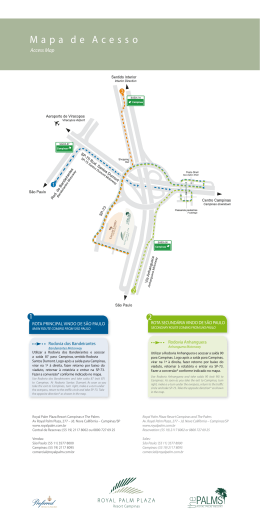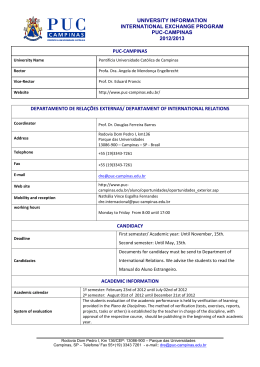Proceedings of COBEM 2005 Copyright © 2005 by ABCM 18th International Congress of Mechanical Engineering November 6-11, 2005, Ouro Preto, MG STRUCTURAL ANALYSIS OF AN AUXILIARY TOTAL ARTIFICIAL HEART: TWO HYPOTHESES FOR THE LOSS OF RESISTANCE DURING "IN VIVO" ANIMAL TESTS Eduardo Guy Perpétuo Bock Department of Bioengineering, Institute Dante Pazzanese of Cardiology. Av. Dr. Dante Pazzanese, 500. Ibirapuera, São Paulo. Faculty of Mechanical Engineering, Campinas State University. Cidade Universitária Zeferino Vaz, Campinas, SP. [email protected] Edivânia Aparecida Eugênio Wada Department of Bioengineering, Institute Dante Pazzanese of Cardiology. Av. Dr. Dante Pazzanese, 500. Ibirapuera, São Paulo. Faculty of Mechanical Engineering, Campinas State University. Cidade Universitária Zeferino Vaz, Campinas, SP. [email protected] Antonio Celso Fonseca de Arruda Faculty of Mechanical Engineering, Campinas State University. Cidade Universitária Zeferino Vaz, Campinas, SP. [email protected] Aron José Pazin de Andrade Department of Bioengineering, Institute Dante Pazzanese of Cardiology. Av. Dr. Dante Pazzanese, 500. Ibirapuera, São Paulo. [email protected] Jeison W. Gomes da Fonseca Department of Bioengineering, Institute Dante Pazzanese of Cardiology. Av. Dr. Dante Pazzanese, 500. Ibirapuera, São Paulo. [email protected] Leonardo Martins Department of Bioengineering, Institute Dante Pazzanese of Cardiology. Av. Dr. Dante Pazzanese, 500. Ibirapuera, São Paulo. [email protected] Juliana Leme Department of Bioengineering, Institute Dante Pazzanese of Cardiology. Av. Dr. Dante Pazzanese, 500. Ibirapuera, São Paulo. [email protected] Denys Emilio C. Nicolosi Department of Bioengineering, Institute Dante Pazzanese of Cardiology. Av. Dr. Dante Pazzanese, 500. Ibirapuera, São Paulo. [email protected] José Francisco Biscegli Department of Bioengineering, Institute Dante Pazzanese of Cardiology. Av. Dr. Dante Pazzanese, 500. Ibirapuera, São Paulo. [email protected] Abstract. The Auxiliary Total Artificial Heart (ATAH) is a compact electromechanical artificial heart that works simultaneously with the natural heart for Uni and Biventricular Assistance. As a bridge to transplant, it could increase the chances to patients who are waiting for a heart. The ATAH is being tested in animals as a Left Ventricle Assist Device (LVAD). During the surgery of those tests, when the system is assembled, some cracks appeared in a specific region of the chamber turning the entire piece fragile. Two hypotheses were formulated to solve this problem. The first: "In case the material would be changed, maintaining all building details but changing the acrylic resin on epoxy resin, the resistance necessary to the tests could be reached". And the second: "In case the material of chamber would maintained but the thickness would increased from 1.5 mm to 3.0 mm, the chamber cracks couldn't appears on tests ". When the epoxy chambers were made, the material turned more fragile and so weak that broke before the tests. By the way, the hypothesis 1 was discharged. After these changes were made, three experiments were carried ou to test the hypothesis 2 using female calves with nearly 90 kg weight. All the tests were satisfactory and no cracks or faiures were observed, proving that hypothesis number 2 is valid. Keywords: Total Artificial Heart, Auxiliary Total Artificial Heart, Left Ventricular Assistance Device, "In Vivo" Tests, Artificial Organs. 1. Introduction Since Dr. Michael DeBakey developed the first blood pump, many research groups have followed the idea of build a device that makes the heart’s work (DeBakey, 1934). After some modifications these machines became reliable tools and were used to circulate the blood during the heart surgery techniques. Probably, this fact had made a revolution on the cardiology field because without it maybe could be impossible some present surgical treatments. As soon, was initiated the researches with a device capable to provide a ventricular assistance. The Dr. Domingo Liotta performed the first human implantation of a Ventricular Assist Device (VAD) in 1961. He was followed by Dr. Yukihiko Nosé who demonstrated that it was possible an implantation of a Total Artificial Heart (TAH) inside the pericardial sac of calves. Dr. Denton Cooley performed the first human implantation in 1969 (DeVries et al., 1972). Presently, dozens of devices are in study or in clinical application. In Brazil, the project of an Auxiliary Total Artificial Heart (ATAH) was initiated in meadows of 1998. It was possible because an institutional exchange research program between the Institute Dante Pazzanese of Cardiology, Campinas State University and the Baylor College of Surgeons (Andrade et al., 1999). The ATAH is a miniaturized total artificial heart that works simultaneously with the natural heart. In our laboratories, it is being implanted in female calves. Those tests, called “In Vivo” Animal tests means to check the performance of the ATAH and its components (Andrade, 1998). During the implantation of the ATAH in calves, when the system and its connections are assembled, some cracks appeared in a specific region of the chamber turning the entire piece fragile. The aim of this study is to find a reason and solve the problem of the chamber cracks working with two hypotheses. Only one of those was chosen as the plausible hypothesis that solves this problem. The solution was implemented and no more cracks appeared during the "In Vivo" Animal tests. 2. Materials and Methods The ATAH is an electromechanical pulsatile blood pump with two chambers. A Brushless Direct Current Motor (BLDC) is centered in a metallic centerpiece. This BLDC with a planetary roller screw work as the electromechanical actuator of the pump. The planetary roller screw converts the rotation of the BLDC into an axial movement. Alternating the rotation of the BLDC, the roller screw can provide rectilinear motion that advances the left and right diaphragm. This system is assembled to avoid rotation of the stator. The left and right housings are made of resins that could be epoxy resin or acrylic resin. Those two types were generally chosen by its biocompatibility and easily of manufacturing as seen on the Fig. 1 (Andrade, 1998). Cracks' formation area Figure 1. ATAH's chamber with the area that was encountered formation of cracks in evidence. The "In Vivo" Animal tests consist in the implantation of the ATAH in female calves between 80 kg and 100 kg. The system assists the animal by two weeks as a Left Ventricle Assist Device (LVAD). It begins when the veterinary chooses one calf for the implantation one week before the surgery. The criterion used by the veterinary is based on the parameters below. - Cardiac and respiratory conditions; - No presence of dermal lesions that could infect the surgical area; - Rectal temperature lower than 39,3 ºC; - Hematocrit value higher than 28%; and Proceedings of COBEM 2005 Copyright © 2005 by ABCM 18th International Congress of Mechanical Engineering November 6-11, 2005, Ouro Preto, MG - Biochemist of the liver and normal kidney function. According to the internal Committee of Ethics on Animal Experiments was decided that three animals is relevant to the present work. The surgery follows the internal Protocol for ATAH's implantation. This protocol specify the animal preparation, anesthesia, anticoagulation, surgical act, analysis of data from laboratories and euthanasia (Andrade et al., 1999). Two hypotheses were formulated to solve the problem of cracks in the resin chambers. 2.1. Hypothesis number 1 The first hypothesis formulated is: "In case the material would be changed, maintaining all building details but changing the acrylic resin on epoxy resin, the resistance necessary to the tests could be reached". To check this hypothesis we changed the material of the chamber from acrylic resin on epoxy resin that has different values of mechanical resistance. The thickness was maintained in 1.5 mm to don't intervene on the results. 2.2. Hypothesis number 2 The second hypothesis formulated is: "In case the material of chamber would maintained but the thickness would increased from 1.5 mm to 3.0 mm, the chamber cracks couldn't appears on tests ". To check this hypothesis we continued to use the acrylic resin but we changed the thickness. Doing it we waited to view how the crack's formation area could be reinforced. 3. Results and conclusions During the manufacturing of the chambers with epoxy resin, we observed that, after the polymerization, it turned the material more hard. Even with this hardness increasing, the chamber was turned fragile and so weak that broke before the "In Vivo" tests showing a lower mechanical resistance. By the way, the hypothesis number one was discharged and only the tests with the hypothesis number two was performed. After these changes were made, three experiments were carried ou to test the hypothesis 2 using female calves with nearly 90 kg weight. All the tests were satisfactory and no cracks or faiures were observed. We conclude the hypothesis number 2 was the best choice to solve the problem of cracks' appearing. The alterations of thickness reinforced the chamber's critical area. It proved that the chamber had a fail in the mechanical design project and it caused the low resistance. As predicted by Affeld, Schamweber and Claussen (1983), the use of computer graphics' software is a reliable tool to the design project of total artificial hearts. 4. Acknowledgements We would like to thank the CNPq and Capes by the partially financing the ATAH project. 5. References Affeld K., Schamweber H., Claussen C., 1983, “The use of computer graphics to find an optimal fit for a human total artificial heart”, Transactions of American Society of Artificial Internal Organs, Vol. 29, pp. 103-9. Andrade, A. “Projeto, protótipo e testes ‘in vitro’ e ‘in vivo’ de um novo modelo de coração artificial total (TAH) por princípio eletro-mecânico de funcionamento” – Campinas. 1998. (Dissertação de Doutorado – Faculdade de Engenharia Mecânica da Universidade Estadual de Campinas). Andrade, A. et al., 1999, “Um novo modelo de coração artificial totalmente implantável e heterotópico”, Revista Brasileira de Cirurgia Cardiovascular, Vol. 4, pp. 128-134. De Bakey, 1934, “A simple continuous flow blood transfusion instrument”, New Orleans Med. Surgery Journal, No 87, pp. 386. De Vries, W.C, et al., 1972, “Clinical use of the total artificial heart”, New England Journal of Medicine, Vol. 1, pp. 310:273. 6. Responsibility notice The authors are the only responsible for the printed material included in this paper.
Download
